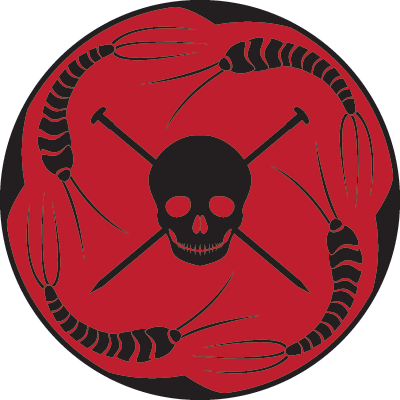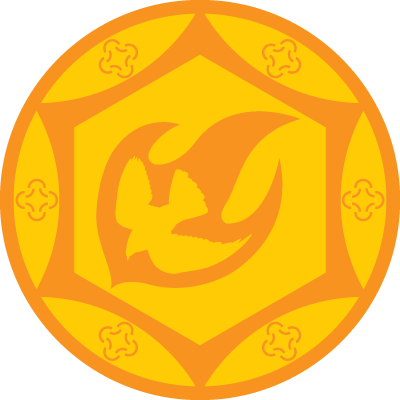
With the onset of his career as a blood-thirsty marauder, Patrick Guthwine, being keenly aware of his own deficiencies in the areas of personal prowess, tactics, and general seamanship, commissioned his mother to make a flag which would set him apart from the other sundry pirates and communicate by sheer nastiness of visage general thoughts of surrender and suchlike things to the minds of those unfortunate enough to gaze upon said bit of cloth on the high seas. His mother was only to happy to lend any amount of aid to her son’s financial endeavors being of the opinion that as Patrick had already failed in every other career he had ever gotten himself into, he would need as much aid as he could get. So, on the eve of her son’s maiden voyage Jemima Guthwine proudly presented him with the flag he had requested and sent him on his way, apparently unaware of the mental anguish which this gift had cast over Patrick.
Scholars generally agree that the dark image, which Patrick Guthwine had intended as the outer face of his persona had almost certainly been a black scorpion, but either because Jemima was unfamiliar with scorpions or that she disagreed with her son artistically, the flag he flew on his first voyage, bore the image of a black silverfish. “It may even have been miscommunication,” says one such scholar, “In a moment of mental abstraction, Patrick may very well have just waved his hand vaguely and said, ‘Oh, you know, those arthropods with tails.’”
At any rate, when Captain Guthwine reentered port two days later to pick up the powder kegs he had inadvertently left behind, he made the mistake of patronizing the local tavern. The other clientele, his fellow sea captains, felt it necessary to enlighten Patrick as to the extent to which he was entertaining the local populace. They made it perfectly clear that to be symbolized by what was essentially an upper class cockroach was not at all lacking in the humorous. Patrick Guthwine tragically died in the brawl that fallowed and his already disillusioned crew abandoned the ship and scattered to the winds.
When Jemima Guthwine was informed of the event and circumstances of her son’s death she rounded up her younger relations and, livid over the insult to her handiwork which she found to be quite well up in the viciousness department, set out in her son’s ship to track down those responsible.
The slaughters that fallowed were purportedly ghastly to behold. Within the space of three weeks Jemima Guthwine had sent four ships to the bottom. Thus obtaining a fondness for life at sea Jemima continued on, carving herself a place as the thirteenth most feared pirate of that time. This number, though, was no accurate depiction of the woman’s tenacity and bloodthirstiness which was well above that of any other pirate captain. She was, as one historian puts it, “a knitter.” In fact, the only reason Jemima did not attain the status of other less dangerous men was that the rampant destruction and death that marked her pirating exploits were only sporadic, accruing only when the orchestrator of such events was running low on wool.
But even if it was slowly, hampered by infrequency and the short life expectancy of eyewitnesses, news was spreading. In a letter to the family taxidermist Jemima’s nephew Archibald describes his aunt, “The old lady would set into battle with a glee bordering on the infernal.” And soon whispers and only half-believed tails of the Black Silverfish, Demon Granny of the Caribbean were heard in taverns the world over.
The ultimate fate of Jemima Guthwine remains clouded in mystery and though her involvement in the Lady Katherine affair is probable, the details concerning that event are known only to few.
Oracle of the Closet Illustrator, Seals, Umbraverse
 A renowned archeologist and medievalist, he stumbled upon the fact of League’s existence while pursuing his pet project, namely, the Holy Grail. The League was impressed by his natural talent and asked him to join; in return, they offered what information they had about Lord Couch’s involvement in that ancient quest. It was through his tracing of League history that the good doctor finally found the Grail, but it is for his later discoveries that he is honored by the greater portion of the Umbralites.
A renowned archeologist and medievalist, he stumbled upon the fact of League’s existence while pursuing his pet project, namely, the Holy Grail. The League was impressed by his natural talent and asked him to join; in return, they offered what information they had about Lord Couch’s involvement in that ancient quest. It was through his tracing of League history that the good doctor finally found the Grail, but it is for his later discoveries that he is honored by the greater portion of the Umbralites. Perhaps the most powerful and mysterious umbralite in history, she simply breezed in one day and assumed leadership of the League. She bested the dire parrot Phooter and imprisoned his soul within her umbrella, bringing the psittacines back into their old alliances. She addressed the deteriorating power of governesses by instituting the Order of the Nannies to combat the spread of demon children. Her list of exploits, both confirmed and rumored, is truly vast.
Perhaps the most powerful and mysterious umbralite in history, she simply breezed in one day and assumed leadership of the League. She bested the dire parrot Phooter and imprisoned his soul within her umbrella, bringing the psittacines back into their old alliances. She addressed the deteriorating power of governesses by instituting the Order of the Nannies to combat the spread of demon children. Her list of exploits, both confirmed and rumored, is truly vast. Her real name is unknown, as are her origins. She was called “St. Paul’s Sentinel” by the local washerwomen, and “the Heart of London” by the vagrantory element. The only name she gave the League was “The Bird Woman.” In respect to all of which, the Avatar is recorded as remarking, “They all work in their own way, though the official version is more to the point. The first merely implies that she sits on the cathedral steps all day doing nothing in particular, which she does but that’s not the point. The second is a technically accurate, but misleading, metaphor. Unless, of course, it was made by someone with a separate circulatory system for their platelets, which they might, you never can tell.”
Her real name is unknown, as are her origins. She was called “St. Paul’s Sentinel” by the local washerwomen, and “the Heart of London” by the vagrantory element. The only name she gave the League was “The Bird Woman.” In respect to all of which, the Avatar is recorded as remarking, “They all work in their own way, though the official version is more to the point. The first merely implies that she sits on the cathedral steps all day doing nothing in particular, which she does but that’s not the point. The second is a technically accurate, but misleading, metaphor. Unless, of course, it was made by someone with a separate circulatory system for their platelets, which they might, you never can tell.” His unaccountable fixation with the principals of extra-aerodynamic flight resulted in many raised eyebrows over the years. For the most part considered a harmless eccentric by his colleagues at Oxford, he was mostly ignored by the scholarly world, which had learned early on that getting into technical conversations was injurious to one’s mental balance.
His unaccountable fixation with the principals of extra-aerodynamic flight resulted in many raised eyebrows over the years. For the most part considered a harmless eccentric by his colleagues at Oxford, he was mostly ignored by the scholarly world, which had learned early on that getting into technical conversations was injurious to one’s mental balance.  More often referred to as “the deacon’s wife;” an accomplished organist, dove breeder, chemist, and haberdasher, she was known chiefly by her reputation within her congregation. No one ever really bothered to remember her actual name; the one given to posterity is, in fact, a chimera formed out of people’s best guesses.
More often referred to as “the deacon’s wife;” an accomplished organist, dove breeder, chemist, and haberdasher, she was known chiefly by her reputation within her congregation. No one ever really bothered to remember her actual name; the one given to posterity is, in fact, a chimera formed out of people’s best guesses.  Something of an enigma, she exists more as a popular legend than a historical personage in the minds of the greater populace. In fact, many scholars insist that the lady never actually existed at all, but was, instead, only a metaphor for something or other, and later, a fabrication for the purposes of lending credence to the “Lost Dauphin” theories.
Something of an enigma, she exists more as a popular legend than a historical personage in the minds of the greater populace. In fact, many scholars insist that the lady never actually existed at all, but was, instead, only a metaphor for something or other, and later, a fabrication for the purposes of lending credence to the “Lost Dauphin” theories. Originally an informer and naval insurgent of Beatrice Emberlane’s, instrumental in the capture of the H.M.S. Rosings. He was subsequently killed during his mission to draw the insidious leader of the East India Trading Company out of the shadows, but was brought back to life by a time-traveling sorceress possessed of a heated personal rivalry with a local deity.
Originally an informer and naval insurgent of Beatrice Emberlane’s, instrumental in the capture of the H.M.S. Rosings. He was subsequently killed during his mission to draw the insidious leader of the East India Trading Company out of the shadows, but was brought back to life by a time-traveling sorceress possessed of a heated personal rivalry with a local deity.

